RECONDITIONING TUBES
![]() 18-jun-2022
18-jun-2022
|
|
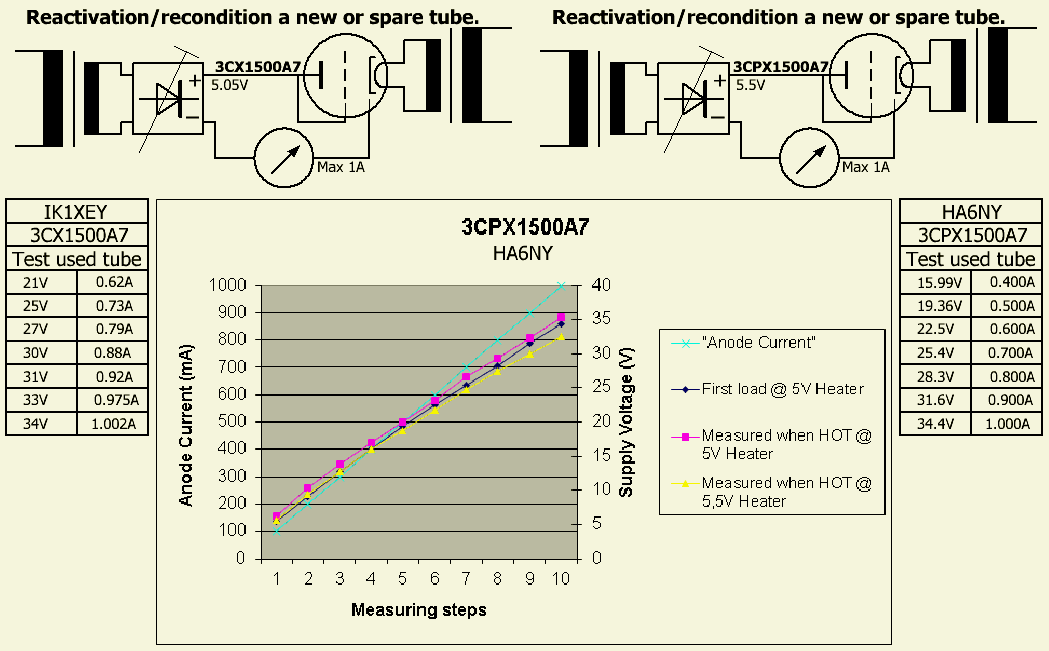 |
EMISSION
|
Deforming of the anode due to inefficient cooling. |
The filament of a tube with either directly or indirectly heated cathode emits a flow of electrons, which depends on the voltage on the anode and grids. Even if the tube is cut-off electrons are emitted. This is a continuous process that ends when the cathode is "exhausted". In a tube having a directly heated cathode, the emission gradually decreases, the tube becomes "soft". Emissions of an indirectly heated tube can drop quite suddenly and is often accompanied by an increase of arcing (flashover). Furthermore, the filament suffers the most from switching because the warming up caused more damage than standby. Therefore, in a broadcasting transmitter the filaments are not switched off after the end of a transmission. Does not switch off the filaments if you using a PA at different times a day, then a tube will last an amateur lifetime.
In general, the most wear is due to overload (overdrive) and insufficient cooling. Excessive ventilation is better than poor cooling. Overheating (fig») the tube (seals) can damage the gas density of metal with glass or ceramic compounds. Also a heavy inrush current causes a too rapid expansion of the metal causing permanent damage.
Probably you also always keep a few spare tubes in stock. Why? You know the practice, if one get rid of spare tubes probably the next day the PA's tube is broken (according to Murphy's law). It is wise to use the spare tubes once a year to stabilise the state of cathode and vacuum. A tube is never absolutely gas-tight. In the course of time, molecular particles sliding along the pins into the tube. Therefore combinations of substances (getter) are added to cure, but the longer the spare tube is unused the more the vacuum will be polluted,one sees a bluish glow close to the anode if the tube is in action.
REACTIVATING OR RECONDITIONING A TUBE
|
Still works well despite the black color! |
To prevent arcing in a new or long time unused tube, it is wise to prepare (reactivate) for his task. It should "initiated" by heating or "degassing" in order to optimise cathode and vacuum. Residue of gas is removed or absorbed, and the cathode regains its optimal emission. If that is omitted, there is a greater risk of spark-over (flashover) between anode and other internal connections. That may be a (permanent) damage to cathode, filament and grids. Damage to a tube can also be the cause of arcing and decreased transmitting power.
The reactivation is the easiest by heating in the amplifier. Disconnect the anode voltage and heat the tube for about one hour with the filaments on and put the fan off. Note: many ceramic tubes are overheated with the fan "off".
Reconnect anode HV, activate the fan and get the tube to draw the specified idling current while holding down the PTT switch. Then leave to stand for at least an hour. To prevent any oscillation during the process, the output should be connected to a dummy load. After this treatment and if everything remains stable the drive may gradually be increased to the specified value or to the maximum anode current. So if one think a tube is worn or "useless" do not throw away, see fig»!
ANOTHER METHOD OF RECONDITIONING
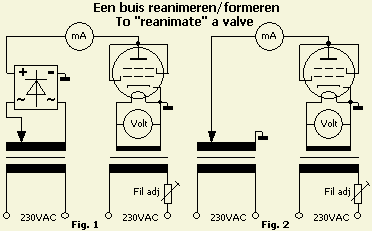
On the Internet you can find all kinds of complex, colourful, cumbersome and lengthy procedures to achieve the same result, but try this old fashioned method: Get a socket, heater transformer, mA-meter and a variable DC supply. Connect the filament and connect all grids to the anode. Note: the tube is temporarily used as diode so that the required anode current is obtained with low DC voltage. Heat the tube for one hour with only the filament voltage on. Then apply DC, set the voltage and see if any current flows gently adjust the voltage for maximum allowable anode current.
VARIOUS TUBES
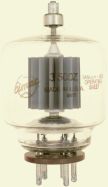
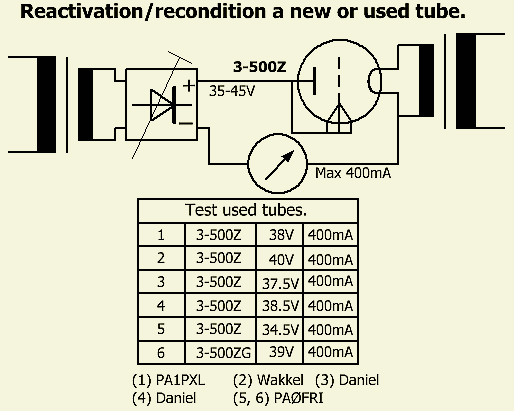
The reconditioning of a 3-500Z is relatively simple. With a DC voltage 0 - 40 V you should be able to get around 400 mA anode current with maximum 40 V DC on the anode. Apply 4.9 V to the filament and "cook" the tube for an hour. Then connect the variable supply and adjust DC for 400 mA anode current The process must be maintained until for example a stable 38 V/400 mA is obtained.
|
|
|
|
|
|
|
|
|
|
|
|
|
|
|
|
|
|
|
|
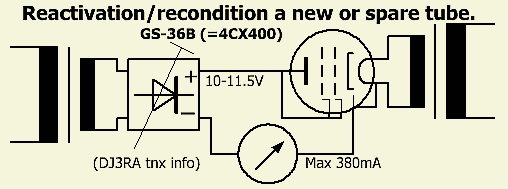 |
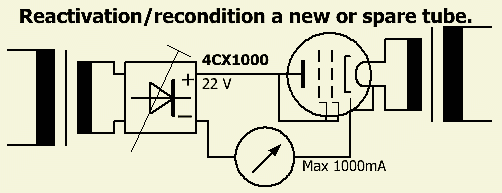 |
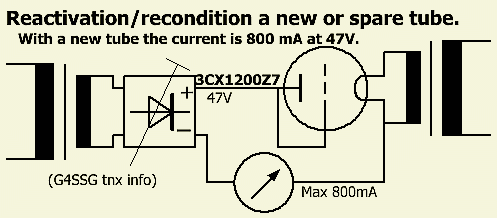 |
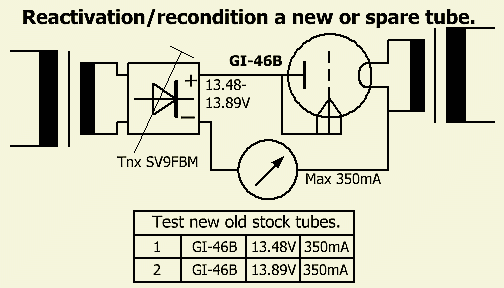 |
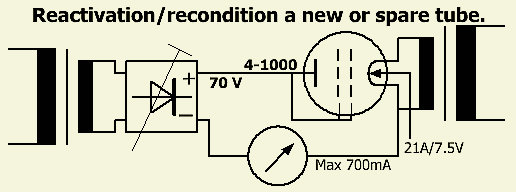 |
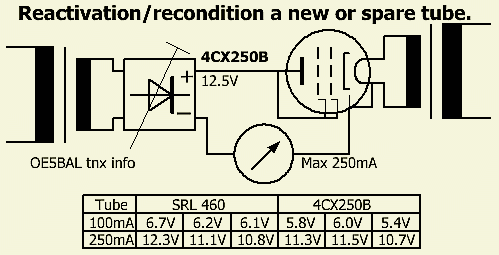 |
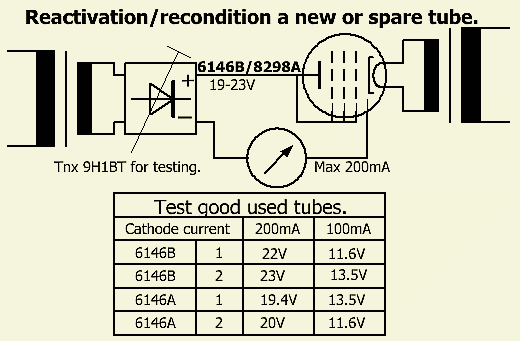 |
A tube is not cooled unless the manufacturer requires that its product (eg ceramic tube) must be cooled as the filament is on. Eventually use a fan for the seals to prevent over heating. If a tube is new or for a long time unused, the current will gradually increase so that the voltage had to be decreased. Actually the fixture should be permanently monitored because it is possible that the current suddenly jumps to a higher value, a sign that the tube becomes "better". If for a period of a couple of hours the anode current remains stable at a particular voltage for example GU-43B: 12 V/800 mA, then the reactivation may be terminated.
One may extend the reconditioning, my experience is that after 2 - 5 hours the process can be stopped because the tube is worn out but it's worth a try.
SOME TUBES TESTED IN RF AMPLIFIER
In my home made PA I have tested some of my tubes and borrowed ones. The driving power (Pi) was respectively 10-, 50- and 100 W. At each step, the output power (Po), grid current (Ig) and anode current (Ia) was listed at an anode voltage of 2500 V and 1700 V. Please note that some tubes are overloaded as experiment.
See tables: Table 1, Table 2, Table 3, Table 4.
All measurements were carried out under the same conditions as much as possible. There is no account of up to 10 V changes of the supply voltage. A DAIWA CN101-L power meter was calibrated in two ranges 100 W and 400 W at 14.2 MHz. On 10 and 160 m bands, the meter indication was less than the reality, but the corresponding values are listed in the tables.
SAFETY
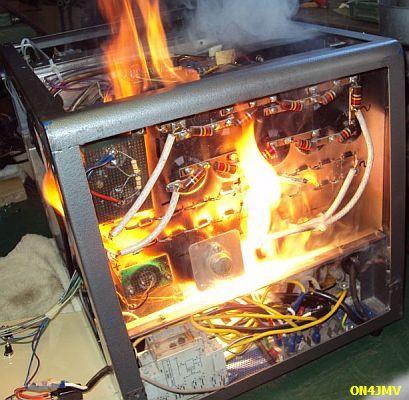

Be careful, prevention is better than cure.
ON4JMV wrote: "a GU-43B was modified according to your instructions. The tube was not used for a long period of time. I wanted a degassing process during the night with filament and anode voltages on. The next morning I saw that a fuse of the mains fuse box was blown. I replaced a new fuse and the PA started up normally, but after a few seconds I heard a strange stronger becoming hum, immediately I realised that the high voltage transformer was burning out! There was some smoke and happily my camera was on hand so I took in a reflex a few pictures. During the third shot the transformer was on fire. The worst thing was that fuse of the mains fuse box did not blow. This could happen at night with dangerous and annoying consequences.
NEVER OR NEVER leave an operating device unattended. One can not always be as lucky or how a hobby could turn into a nightmare. "
So beware, be careful!
OK1AMF
For reactivating his tubes, OK1AMF has taken the trouble to make an extensive test setup.
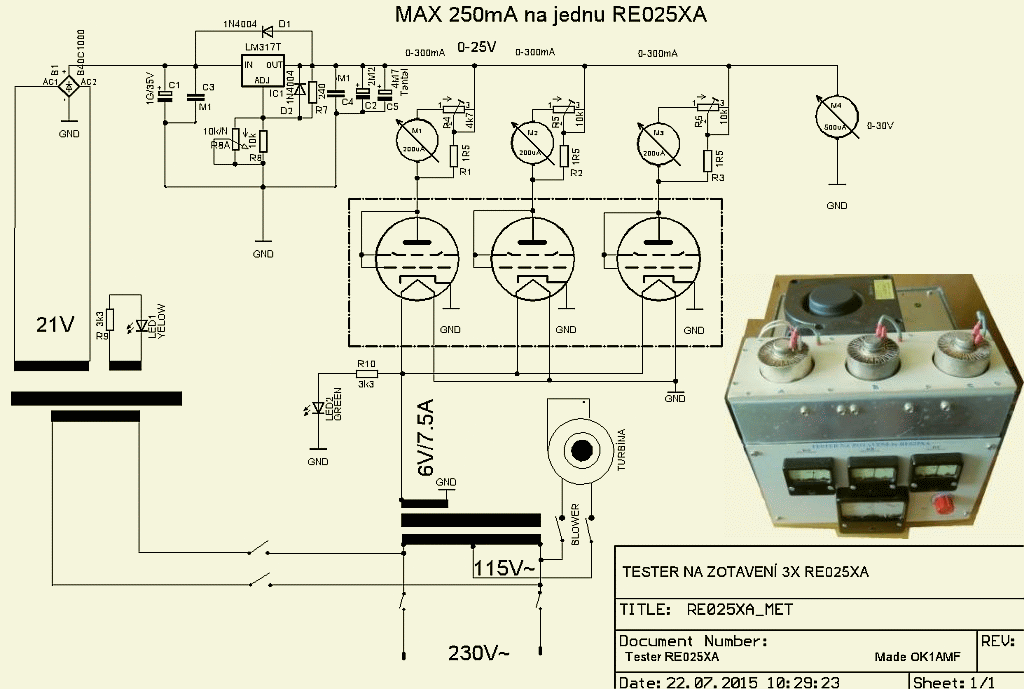
DL6NAA describes his reaktivator.
It is not recommended to install a 3-500Z horizontal, because the filament will gradually sag and short circuit may occur between grid and filament. The tube's specs states that it must be mounted vertically.
G8TIC was sceptical.
![]()